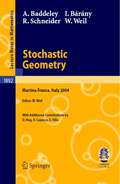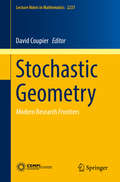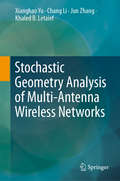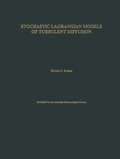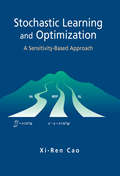- Table View
- List View
Stochastic Geometry: Lectures given at the C.I.M.E. Summer School held in Martina Franca, Italy, September 13-18, 2004 (Lecture Notes in Mathematics #1892)
by A. Baddeley I. Bárány R. Schneider W. WeilStochastic Geometry is the mathematical discipline which studies mathematical models for random geometric structures. This book collects lectures presented at the CIME summer school in Martina Franca in September 2004. The main lecturers covered Spatial Statistics, Random Points, Integral Geometry and Random Sets. These are complemented by two additional contributions on Random Mosaics and Crystallization Processes. The book presents a comprehensive and up-to-date description of important aspects of Stochastic Geometry.
Stochastic Geometry: Selected Topics
by Viktor Benes Jan RatajStochastic geometry, based on current developments in geometry, probability and measure theory, makes possible modeling of two- and three-dimensional random objects with interactions as they appear in the microstructure of materials, biological tissues, macroscopically in soil, geological sediments etc. In combination with spatial statistics it is used for the solution of practical problems such as the description of spatial arrangements and the estimation of object characteristics. A related field is stereology, which makes possible inference on the structures, based on lower-dimensional observations. Unfolding problems for particle systems and extremes of particle characteristics are studied. The reader can learn about current developments in stochastic geometry with mathematical rigor on one hand and find applications to real microstructure analysis in natural and material sciences on the other hand.
Stochastic Geometry: Modern Research Frontiers (Lecture Notes in Mathematics #2237)
by David CoupierThis volume offers a unique and accessible overview of the most active fields in Stochastic Geometry, up to the frontiers of recent research. Since 2014, the yearly meeting of the French research structure GDR GeoSto has been preceded by two introductory courses. This book contains five of these introductory lectures. The first chapter is a historically motivated introduction to Stochastic Geometry which relates four classical problems (the Buffon needle problem, the Bertrand paradox, the Sylvester four-point problem and the bicycle wheel problem) to current topics. The remaining chapters give an application motivated introduction to contemporary Stochastic Geometry, each one devoted to a particular branch of the subject: understanding spatial point patterns through intensity and conditional intensities; stochastic methods for image analysis; random fields and scale invariance; and the theory of Gibbs point processes. Exposing readers to a rich theory, this book will encourage further exploration of the subject and its wide applications.
Stochastic Geometry: Likelihood and Computation
by Wilfrid S. KendallStochastic geometry involves the study of random geometric structures, and blends geometric, probabilistic, and statistical methods to provide powerful techniques for modeling and analysis. Recent developments in computational statistical analysis, particularly Markov chain Monte Carlo, have enormously extended the range of feasible applications. Stochastic Geometry: Likelihood and Computation provides a coordinated collection of chapters on important aspects of the rapidly developing field of stochastic geometry, including: o a "crash-course" introduction to key stochastic geometry themeso considerations of geometric sampling bias issueso tesselationso shapeo random setso image analysiso spectacular advances in likelihood-based inference now available to stochastic geometry through the techniques of Markov chain Monte Carlo
Stochastic Geometry: Likelihood and Computation
by Wilfrid S. KendallStochastic geometry involves the study of random geometric structures, and blends geometric, probabilistic, and statistical methods to provide powerful techniques for modeling and analysis. Recent developments in computational statistical analysis, particularly Markov chain Monte Carlo, have enormously extended the range of feasible applications. Stochastic Geometry: Likelihood and Computation provides a coordinated collection of chapters on important aspects of the rapidly developing field of stochastic geometry, including: o a "crash-course" introduction to key stochastic geometry themeso considerations of geometric sampling bias issueso tesselationso shapeo random setso image analysiso spectacular advances in likelihood-based inference now available to stochastic geometry through the techniques of Markov chain Monte Carlo
Stochastic Geometry Analysis of Multi-Antenna Wireless Networks
by Xianghao Yu Chang Li Jun Zhang Khaled B. LetaiefThis book presents a unified framework for the tractable analysis of large-scale, multi-antenna wireless networks using stochastic geometry. This mathematical analysis is essential for assessing and understanding the performance of complicated multi-antenna networks, which are one of the foundations of 5G and beyond networks to meet the ever-increasing demands for network capacity. Describing the salient properties of the framework, which makes the analysis of multi-antenna networks comparable to that of their single-antenna counterparts, the book discusses effective design approaches that do not require complex system-level simulations. It also includes various application examples with different multi-antenna network models to illustrate the framework’s effectiveness.
Stochastic Geometry and Its Applications (Wiley Series in Probability and Statistics #991)
by Sung Nok Chiu Dietrich Stoyan Wilfrid S. Kendall Joseph MeckeAn extensive update to a classic text Stochastic geometry and spatial statistics play a fundamental role in many modern branches of physics, materials sciences, engineering, biology and environmental sciences. They offer successful models for the description of random two- and three-dimensional micro and macro structures and statistical methods for their analysis. The previous edition of this book has served as the key reference in its field for over 18 years and is regarded as the best treatment of the subject of stochastic geometry, both as a subject with vital applications to spatial statistics and as a very interesting field of mathematics in its own right. This edition: Presents a wealth of models for spatial patterns and related statistical methods. Provides a great survey of the modern theory of random tessellations, including many new models that became tractable only in the last few years. Includes new sections on random networks and random graphs to review the recent ever growing interest in these areas. Provides an excellent introduction to theory and modelling of point processes, which covers some very latest developments. Illustrate the forefront theory of random sets, with many applications. Adds new results to the discussion of fibre and surface processes. Offers an updated collection of useful stereological methods. Includes 700 new references. Is written in an accessible style enabling non-mathematicians to benefit from this book. Provides a companion website hosting information on recent developments in the field www.wiley.com/go/cskm Stochastic Geometry and its Applications is ideally suited for researchers in physics, materials science, biology and ecological sciences as well as mathematicians and statisticians. It should also serve as a valuable introduction to the subject for students of mathematics and statistics.
Stochastic Geometry and Its Applications (Wiley Series in Probability and Statistics)
by Sung Nok Chiu Dietrich Stoyan Wilfrid S. Kendall Joseph MeckeAn extensive update to a classic text Stochastic geometry and spatial statistics play a fundamental role in many modern branches of physics, materials sciences, engineering, biology and environmental sciences. They offer successful models for the description of random two- and three-dimensional micro and macro structures and statistical methods for their analysis. The previous edition of this book has served as the key reference in its field for over 18 years and is regarded as the best treatment of the subject of stochastic geometry, both as a subject with vital applications to spatial statistics and as a very interesting field of mathematics in its own right. This edition: Presents a wealth of models for spatial patterns and related statistical methods. Provides a great survey of the modern theory of random tessellations, including many new models that became tractable only in the last few years. Includes new sections on random networks and random graphs to review the recent ever growing interest in these areas. Provides an excellent introduction to theory and modelling of point processes, which covers some very latest developments. Illustrate the forefront theory of random sets, with many applications. Adds new results to the discussion of fibre and surface processes. Offers an updated collection of useful stereological methods. Includes 700 new references. Is written in an accessible style enabling non-mathematicians to benefit from this book. Provides a companion website hosting information on recent developments in the field www.wiley.com/go/cskm Stochastic Geometry and its Applications is ideally suited for researchers in physics, materials science, biology and ecological sciences as well as mathematicians and statisticians. It should also serve as a valuable introduction to the subject for students of mathematics and statistics.
Stochastic Geometry, Spatial Statistics and Random Fields: Models and Algorithms (Lecture Notes in Mathematics #2120)
by Volker SchmidtThis volume is an attempt to provide a graduate level introduction to various aspects of stochastic geometry, spatial statistics and random fields, with special emphasis placed on fundamental classes of models and algorithms as well as on their applications, e.g. in materials science, biology and genetics. This book has a strong focus on simulations and includes extensive codes in Matlab and R which are widely used in the mathematical community. It can be seen as a continuation of the recent volume 2068 of Lecture Notes in Mathematics, where other issues of stochastic geometry, spatial statistics and random fields were considered with a focus on asymptotic methods.
Stochastic Geometry, Spatial Statistics and Random Fields: Asymptotic Methods (Lecture Notes in Mathematics #2068)
by Evgeny SpodarevThis volume provides a modern introduction to stochastic geometry, random fields and spatial statistics at a (post)graduate level. It is focused on asymptotic methods in geometric probability including weak and strong limit theorems for random spatial structures (point processes, sets, graphs, fields) with applications to statistics. Written as a contributed volume of lecture notes, it will be useful not only for students but also for lecturers and researchers interested in geometric probability and related subjects.
Stochastic Global Optimization (Springer Optimization and Its Applications #9)
by Anatoly Zhigljavsky Antanasz ZilinskasThis book examines the main methodological and theoretical developments in stochastic global optimization. It is designed to inspire readers to explore various stochastic methods of global optimization by clearly explaining the main methodological principles and features of the methods. Among the book’s features is a comprehensive study of probabilistic and statistical models underlying the stochastic optimization algorithms.
Stochastic H2/H ∞ Control: A Nash Game Approach
by Weihai Zhang Lihua Xie Bor-Sen ChenThe H∞ control has been one of the important robust control approaches since the 1980s. This book extends the area to nonlinear stochastic H2/H∞ control, and studies more complex and practically useful mixed H2/H∞ controller synthesis rather than the pure H∞ control. Different from the commonly used convex optimization method, this book applies the Nash game approach to give necessary and sufficient conditions for the existence and uniqueness of the mixed H2/H∞ control. Researchers will benefit from our detailed exposition of the stochastic mixed H2/H∞ control theory, while practitioners can apply our efficient algorithms to address their practical problems.
Stochastic H2/H ∞ Control: A Nash Game Approach
by Weihai Zhang Lihua Xie Bor-Sen ChenThe H∞ control has been one of the important robust control approaches since the 1980s. This book extends the area to nonlinear stochastic H2/H∞ control, and studies more complex and practically useful mixed H2/H∞ controller synthesis rather than the pure H∞ control. Different from the commonly used convex optimization method, this book applies the Nash game approach to give necessary and sufficient conditions for the existence and uniqueness of the mixed H2/H∞ control. Researchers will benefit from our detailed exposition of the stochastic mixed H2/H∞ control theory, while practitioners can apply our efficient algorithms to address their practical problems.
Stochastic Hydrology and its Use in Water Resources Systems Simulation and Optimization (NATO Science Series E: #237)
by J. B. Marco R. Harboe J. D. SalasStochastic hydrology is an essential base of water resources systems analysis, due to the inherent randomness of the input, and consequently of the results. These results have to be incorporated in a decision-making process regarding the planning and management of water systems. It is through this application that stochastic hydrology finds its true meaning, otherwise it becomes merely an academic exercise. A set of well known specialists from both stochastic hydrology and water resources systems present a synthesis of the actual knowledge currently used in real-world planning and management. The book is intended for both practitioners and researchers who are willing to apply advanced approaches for incorporating hydrological randomness and uncertainty into the simulation and optimization of water resources systems. (abstract) Stochastic hydrology is a basic tool for water resources systems analysis, due to inherent randomness of the hydrologic cycle. This book contains actual techniques in use for water resources planning and management, incorporating randomness into the decision making process. Optimization and simulation, the classical systems-analysis technologies, are revisited under up-to-date statistical hydrology findings backed by real world applications.
Stochastic Inequalities and Applications (Progress in Probability #56)
by Evariste Giné Christian Houdré David NualartConcentration inequalities, which express the fact that certain complicated random variables are almost constant, have proven of utmost importance in many areas of probability and statistics. This volume contains refined versions of these inequalities, and their relationship to many applications particularly in stochastic analysis. The broad range and the high quality of the contributions make this book highly attractive for graduates, postgraduates and researchers in the above areas.
Stochastic Integrals: Proceedings of the LMS Durham Symposium, July 7-17, 1980 (Lecture Notes in Mathematics #851)
by D. WilliamsStochastic Integration and Differential Equations (Stochastic Modelling and Applied Probability #21)
by Philip ProtterIt has been 15 years since the first edition of Stochastic Integration and Differential Equations, A New Approach appeared, and in those years many other texts on the same subject have been published, often with connections to applications, especially mathematical finance. Yet in spite of the apparent simplicity of approach, none of these books has used the functional analytic method of presenting semimartingales and stochastic integration. Thus a 2nd edition seems worthwhile and timely, though it is no longer appropriate to call it "a new approach". The new edition has several significant changes, most prominently the addition of exercises for solution. These are intended to supplement the text, but lemmas needed in a proof are never relegated to the exercises. Many of the exercises have been tested by graduate students at Purdue and Cornell Universities. Chapter 3 has been completely redone, with a new, more intuitive and simultaneously elementary proof of the fundamental Doob-Meyer decomposition theorem, the more general version of the Girsanov theorem due to Lenglart, the Kazamaki-Novikov criteria for exponential local martingales to be martingales, and a modern treatment of compensators. Chapter 4 treats sigma martingales (important in finance theory) and gives a more comprehensive treatment of martingale representation, including both the Jacod-Yor theory and Emery’s examples of martingales that actually have martingale representation (thus going beyond the standard cases of Brownian motion and the compensated Poisson process). New topics added include an introduction to the theory of the expansion of filtrations, a treatment of the Fefferman martingale inequality, and that the dual space of the martingale space H^1 can be identified with BMO martingales. Solutions to selected exercises are available at the web site of the author, with current URL http://www.orie.cornell.edu/~protter/books.html.
Stochastic Integration and Differential Equations: A New Approach (Stochastic Modelling and Applied Probability #21)
by Philip ProtterThe idea of this book began with an invitation to give a course at the Third Chilean Winter School in Probability and Statistics, at Santiago de Chile, in July, 1984. Faced with the problem of teaching stochastic integration in only a few weeks, I realized that the work of C. Dellacherie [2] provided an outline for just such a pedagogic approach. I developed this into aseries of lectures (Protter [6]), using the work of K. Bichteler [2], E. Lenglart [3] and P. Protter [7], as well as that of Dellacherie. I then taught from these lecture notes, expanding and improving them, in courses at Purdue University, the University of Wisconsin at Madison, and the University of Rouen in France. I take this opportunity to thank these institut ions and Professor Rolando Rebolledo for my initial invitation to Chile. This book assumes the reader has some knowledge of the theory of stochastic processes, including elementary martingale theory. While we have recalled the few necessary martingale theorems in Chap. I, we have not provided proofs, as there are already many excellent treatments of martingale theory readily available (e. g. , Breiman [1], Dellacherie-Meyer [1,2], or Ethier Kurtz [1]). There are several other texts on stochastic integration, all of which adopt to some extent the usual approach and thus require the general theory. The books of Elliott [1], Kopp [1], Metivier [1], Rogers-Williams [1] and to a much lesser extent Letta [1] are examples.
Stochastic Integration by Parts and Functional Itô Calculus (Advanced Courses in Mathematics - CRM Barcelona)
by Vlad Bally Lucia Caramellino Rama ContThis volume contains lecture notes from the courses given by Vlad Bally and Rama Cont at the Barcelona Summer School on Stochastic Analysis (July 2012).The notes of the course by Vlad Bally, co-authored with Lucia Caramellino, develop integration by parts formulas in an abstract setting, extending Malliavin's work on abstract Wiener spaces. The results are applied to prove absolute continuity and regularity results of the density for a broad class of random processes.Rama Cont's notes provide an introduction to the Functional Itô Calculus, a non-anticipative functional calculus that extends the classical Itô calculus to path-dependent functionals of stochastic processes. This calculus leads to a new class of path-dependent partial differential equations, termed Functional Kolmogorov Equations, which arise in the study of martingales and forward-backward stochastic differential equations.This book will appeal to both young and senior researchers in probability and stochastic processes, as well as to practitioners in mathematical finance.
Stochastic Integration in Banach Spaces: Theory and Applications (Probability Theory and Stochastic Modelling #73)
by Vidyadhar Mandrekar Barbara RüdigerConsidering Poisson random measures as the driving sources for stochastic (partial) differential equations allows us to incorporate jumps and to model sudden, unexpected phenomena. By using such equations the present book introduces a new method for modeling the states of complex systems perturbed by random sources over time, such as interest rates in financial markets or temperature distributions in a specific region. It studies properties of the solutions of the stochastic equations, observing the long-term behavior and the sensitivity of the solutions to changes in the initial data. The authors consider an integration theory of measurable and adapted processes in appropriate Banach spaces as well as the non-Gaussian case, whereas most of the literature only focuses on predictable settings in Hilbert spaces. The book is intended for graduate students and researchers in stochastic (partial) differential equations, mathematical finance and non-linear filtering and assumes a knowledge of the required integration theory, existence and uniqueness results and stability theory. The results will be of particular interest to natural scientists and the finance community. Readers should ideally be familiar with stochastic processes and probability theory in general, as well as functional analysis and in particular the theory of operator semigroups.
Stochastic Interacting Systems: Contact, Voter and Exclusion Processes (Grundlehren der mathematischen Wissenschaften #324)
by Thomas M. LiggettInteractive particle systems is a branch of probability theory with close connections to mathematical physics and mathematical biology. This book takes three of the most important models in the area, and traces advances in our understanding of them since 1985. It explains and develops many of the most useful techniques in the field.
Stochastic Lagrangian Models of Turbulent Diffusion (Meteorological Monographs)
This book is intended to give atmospheric scientists a basic understanding of the physical and mathematical foundations of stochastic Lagrangian models of turbulent diffusion. It presents the reader with the historical context of the topic, and it provides definitions, criteria and applications for stochastic diffusion.
Stochastic Learning and Optimization: A Sensitivity-Based Approach
by Xi-Ren CaoPerformance optimization is vital in the design and operation of modern engineering systems, including communications, manufacturing, robotics, and logistics. Most engineering systems are too complicated to model, or the system parameters cannot be easily identified, so learning techniques have to be applied. This book provides a unified framework based on a sensitivity point of view. It also introduces new approaches and proposes new research topics within this sensitivity-based framework. This new perspective on a popular topic is presented by a well respected expert in the field.
Stochastic Linear Programming: Models, Theory, and Computation (International Series in Operations Research & Management Science #80)
by Peter Kall János MayerPeter Kall and János Mayer are distinguished scholars and professors of Operations Research and their research interest is particularly devoted to the area of stochastic optimization. Stochastic Linear Programming is a definitive presentation and discussion of the theoretical properties of the models, the conceptual algorithmic approaches, and the computational issues relating to the implementation of these methods to solve problems that are stochastic in nature.
